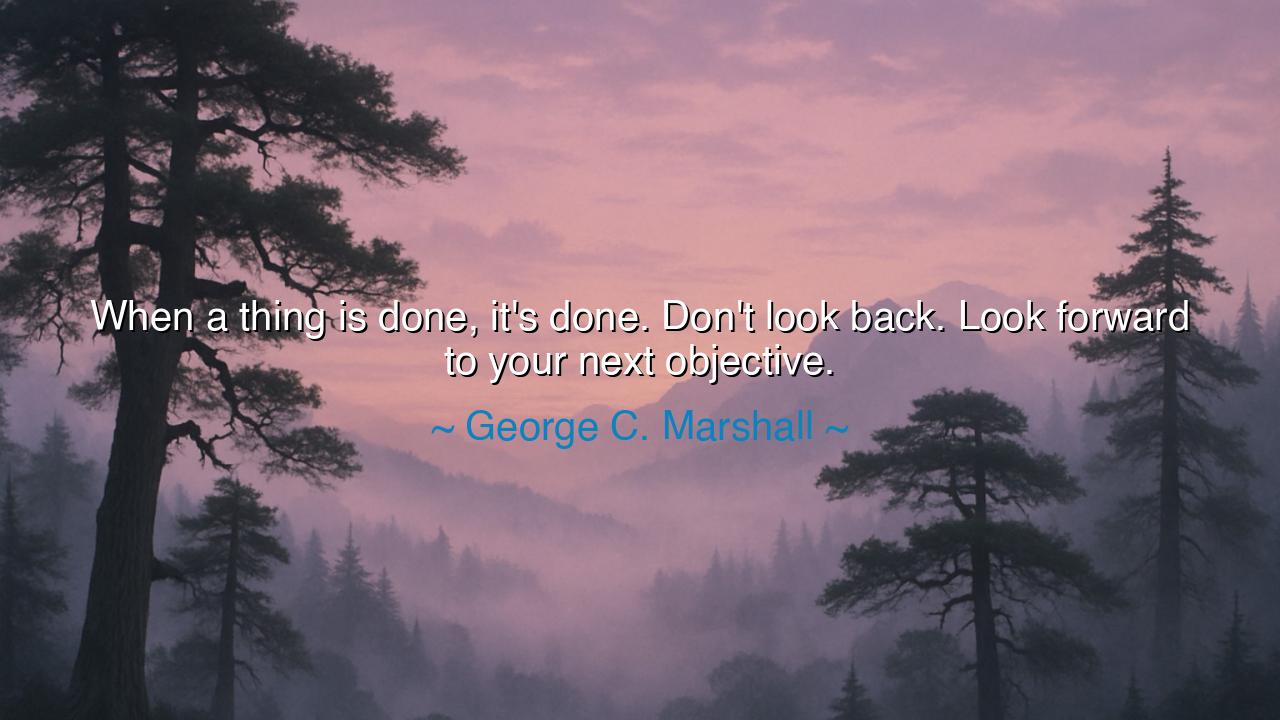
When a thing is done, it's done. Don't look back. Look forward






Hearken, children of the ages, and heed the words of George C. Marshall: “When a thing is done, it's done. Don't look back. Look forward to your next objective.” In these words lies the eternal truth of resolve, perseverance, and the unyielding march of purpose. To linger in the shadows of past deeds, whether triumphant or regrettable, is to burden the spirit and impede the journey toward future greatness. Wisdom lies in accepting the completion of one task and turning the gaze forward, toward the next challenge that beckons.
The origin of this teaching springs from Marshall’s life as a soldier, statesman, and architect of peace in the 20th century. As Army Chief of Staff during the Second World War and later as Secretary of State, he witnessed the weight of victory and loss, the toil of decision, and the necessity of continual action. Marshall’s counsel reminds us that history is not a chain to bind us, but a foundation upon which to build ever greater accomplishments.
Consider the story of Abraham Lincoln, who, in the midst of civil war, faced both successes and setbacks on the battlefield. To dwell endlessly on victories or failures would have paralyzed his leadership; instead, he acted with resolve, learning from experience and directing his efforts to the next strategic objective—the preservation of the Union and the emancipation of the enslaved. In this, he exemplified Marshall’s wisdom: the completed deed is closed, and the future demands vigilance and action.
Even in the ordinary course of life, this teaching resonates. Artisans who complete a work, students who finish a study, and travelers who reach a milestone all find greater fulfillment when they release attachment to the past and press forward toward new endeavors. It is the forward-looking spirit, not the endless reflection on what is already done, that cultivates growth, mastery, and inner peace.
History offers further examples: consider Winston Churchill, who, despite the bitter setbacks of early war campaigns, refused to succumb to despair. He acknowledged the outcomes, whether harsh or favorable, and directed the nation toward the next objective with unwavering determination. The measure of leadership, as Marshall teaches, lies in the ability to act decisively and advance without being shackled by past events.
Therefore, children of future generations, take this counsel to heart: release the completed, embrace the unfolding, and direct your spirit toward the next challenge and higher purpose. Let not the past imprison your resolve; let it instead illuminate the path forward. In this discipline lies the enduring strength of character, the courage of leadership, and the eternal rhythm of purposeful life.






GDGold D.dragon
Cognitively, this seems related to the Zeigarnik effect—unfinished tasks stick in working memory. Do you use external systems to offload residuals—tickler files, checklists for follow-ups, a “parking lot” for deferred ideas—so the mind can release the past effort? I also wonder about counterfactual traps: replaying hypotheticals that don’t change policy. Would a pre-mortem before starting reduce regret afterward, making closure easier? I’m looking for evidence-informed habits that free attention for future goals without losing critical signals from what just happened.
PNPhong Nghia
From a leadership lens, what story do you tell the team at the moment of completion? If you immediately pivot, people may feel their work vanished into a void. If you linger, inertia creeps in. I’d value a template: one slide of outcomes versus intent, one slide of lessons, public thanks, then a crisp handoff to the next charter with owners and first milestones. How do you keep psychological safety—inviting dissent about process—while firmly preventing re-litigation of settled decisions?
TDPhan Thi Thuy Dung
Strategically, moving on only helps if the next target actually serves the mission. How do you prevent a reactive hop from one task to another? I’m thinking of a “why ladder” for each new objective, a constraint on concurrent bets, and reserved recovery capacity so momentum doesn’t become burnout. What horizon do you use to choose the sequel—quarterly OKRs, annual themes, or a rolling roadmap with kill criteria? I’m asking for a prioritization method that links goal sequencing to long-term advantage, not just activity.
MHNguyen Huynh Minh Han
Operationally, the hard part is deciding when something truly meets the bar. Do you set a strict “definition of done” with acceptance criteria, or allow judgment calls when the context shifts? I’m curious about safeguards against quiet scope creep: checklists, exit criteria, and a single accountable owner to declare completion. Also, do you celebrate micro-wins to reinforce closure, or does that dilute focus? I’d appreciate a blueprint that locks in completion, triggers documentation, and immediately queues the next priority without creating busywork.
MXMai Xuan
There’s a psychological angle that’s tricky. Letting go sounds clean, but endings often carry grief, even for successes. How do you create closure without sliding into rumination? What signals tell you it’s time to stop replaying: repeated hypotheticals with no new information, sleep disruption, or conversations that circle rather than converge? I’d love a humane protocol—name the loss, thank the effort, mark the transition with a small celebration, and schedule a future check-in—to convert an ending into energy for what’s ahead.